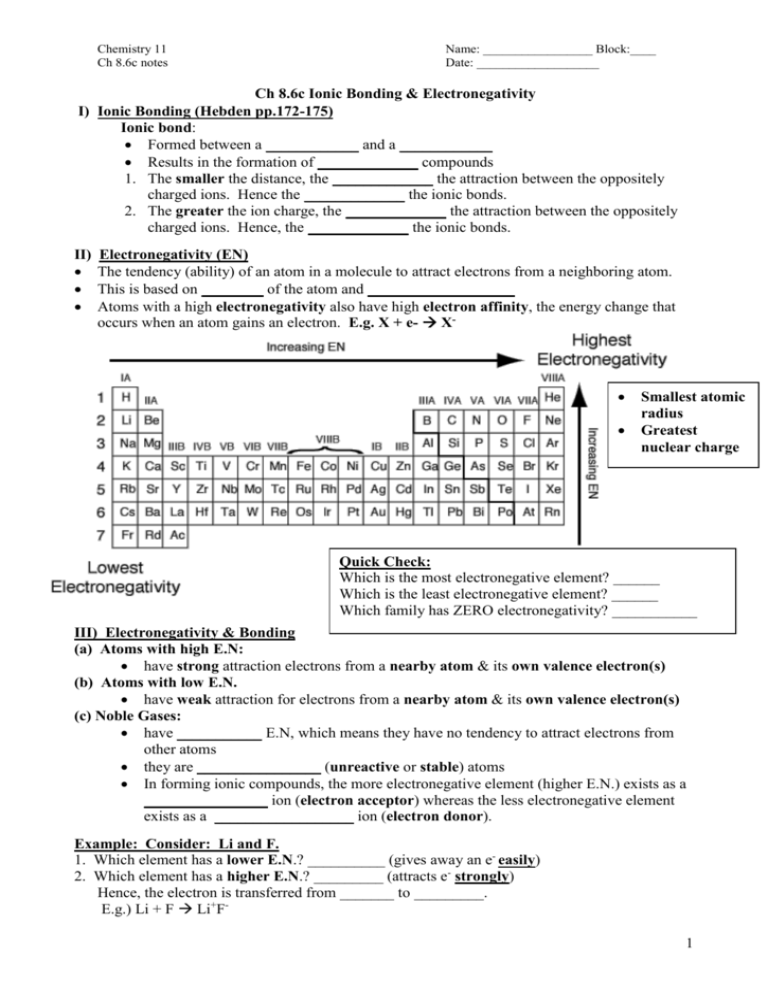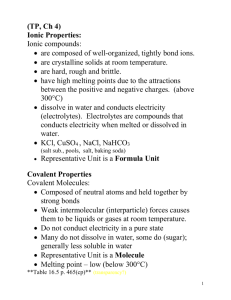The Atomic & Ionic Radii
advertisement

Chemistry 11 Ch 8.6c notes Name: _________________ Block:____ Date: ___________________ Ch 8.6c Ionic Bonding & Electronegativity I) Ionic Bonding (Hebden pp.172-175) Ionic bond: Formed between a ____________ and a ____________ Results in the formation of _____________ compounds 1. The smaller the distance, the _____________ the attraction between the oppositely charged ions. Hence the _____________ the ionic bonds. 2. The greater the ion charge, the _____________ the attraction between the oppositely charged ions. Hence, the _____________ the ionic bonds. II) Electronegativity (EN) The tendency (ability) of an atom in a molecule to attract electrons from a neighboring atom. This is based on ________ of the atom and ___________________ Atoms with a high electronegativity also have high electron affinity, the energy change that occurs when an atom gains an electron. E.g. X + e- X- Smallest atomic radius Greatest nuclear charge Quick Check: Which is the most electronegative element? ______ Which is the least electronegative element? ______ Which family has ZERO electronegativity? ___________ III) Electronegativity & Bonding (a) Atoms with high E.N: have strong attraction electrons from a nearby atom & its own valence electron(s) (b) Atoms with low E.N. have weak attraction for electrons from a nearby atom & its own valence electron(s) (c) Noble Gases: have ___________ E.N, which means they have no tendency to attract electrons from other atoms they are ________________ (unreactive or stable) atoms In forming ionic compounds, the more electronegative element (higher E.N.) exists as a ________________ ion (electron acceptor) whereas the less electronegative element exists as a __________________ ion (electron donor). Example: Consider: Li and F. 1. Which element has a lower E.N.? __________ (gives away an e- easily) 2. Which element has a higher E.N.? _________ (attracts e- strongly) Hence, the electron is transferred from _______ to _________. E.g.) Li + F Li+F1 VI) Ionic Bonding & Melting Point: In general, ionic compounds have higher melting points than covalent compounds. Ionic Compounds Covalent Compounds LiCl KCl CO2 NH3 Compound o 770 605 -56.6 -78 Melting Point ( C) The ions in an ionic compounds are tightly packed in a “lattice” structure This means that the intermolecular bonds (between metal & non-metal ions) cannot be distinguished from the intramolecular bonds (between the ionic compounds) E.g. Check Your Understanding: Consider the following two compounds: LiCl and KCl. LiCl has a melting temperature of 770oC and KCl has a melting temperature of 605oC. Explain why LiCl has a higher melting point according to the Principles of Electrostatics. Draw a diagram to support your answer. Review: 1. Why does E.N. increase across a period? (Hint: think atomic # & charge) 2. Why does E.N. decrease down a column? (Hint: think distance) 3. Two factors affect melting points of ionic compounds: The greater the electrostatic charges between the metal and non-metal ions, the ______________ (higher/lower) the melting point. The greater the distance between the two oppositely charged ions, the _______________(higher/lower) the melting point. Assignment: Hebden p.172 #57, p.173#58-61, p. 175 #62-64 2






